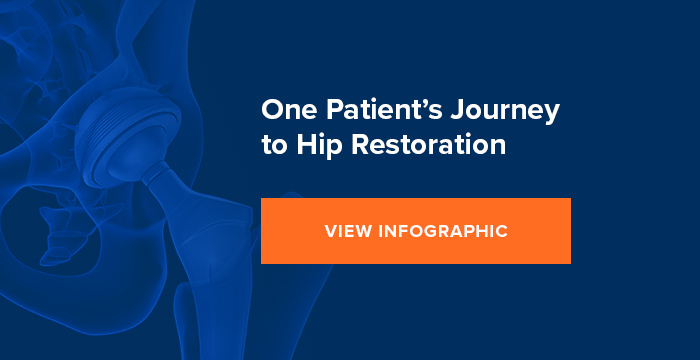
It feels like you have tried every imaginable treatment method for your hip pain…and, performing daily activities (let alone golfing and tennis) has become cumbersome or even impossible. Sound familiar? If so, it may be time to consider hip replacement surgery.
At EmergeOrtho—Triangle Region, we are known for exhausting all non-operative treatment methods before suggesting surgery to our patients. Only together do we create a surgical treatment plan for hip replacement surgery, if and when the time comes. If surgery is recommended, our fellowship-trained surgeons are among the best in the area and across the nation.
From minimally-invasive hip arthroplasty to hip replacement recovery tips, we are here to help guide you on the best way to Emerge Stronger. Healthier. Better—returning you to the activities you enjoy most.
Exploring the Best Hip Replacement Options for You

Many people are curious about which method of hip replacement is the best. Prior to determining the right type of hip replacement for you, your doctor will perform a full examination and consultation. During your visit, your physician will evaluate several factors to confirm that you qualify for surgery. Most people are candidates for a hip replacement if they have the following:
- Hip pain that has not subsided with the aid of conservative treatments
- Hip pain that occurs regardless of whether you are active or resting
- Hip stiffness that restricts mobility in your leg (lifting, moving)
- Hip pain that persists even with the use of anti-inflammatory drugs, physical therapy, and walking supports
Ultimately, hip replacement options vary based on your age, overall health, and which symptoms you exhibit (the list above as an example). Once your doctor confirms that surgery is the right option for you, we’ll go over the following hip replacement procedures to see which is right for you:
- Total Hip Replacement (Arthroplasty)
Your surgeon removes the damaged femoral head of the hip, replacing it with a metal stem. A metal or ceramic ball is placed on the upper portion of the stem. The damaged cartilage surface of the acetabulum (socket) is also removed and replaced with a metal socket. Screws are used to hold the socket in place. A plastic, metal, or ceramic spacer is placed between the new ball and socket to create a gliding surface. - Minimally-Invasive Hip Replacement
Besides using a smaller incision, a minimally-invasive total hip replacement is focused on preserving the normal muscles and tendons around the hip. While the same types of artificial implants used in traditional hip replacement surgery are used, specially-designed surgical instruments are utilized for the procedure. This preserves tissues surrounding the hip to improve the recovery process after surgery. - Direct Anterior Total Hip Replacement
As compared to posterior hip replacement surgery, which is performed from the back of the hip, the anterior (front) technique enables your surgeon to replace the hip without having to detach the muscles from the pelvis. This makes anterior hip replacement one of the least invasive options, reducing patients’ hospital stays, pain, and risk of hip joint dislocation. - MAKOplasty® Total Hip Replacement
As a robotic-arm assisted procedure, MAKOplasty® hip replacement provides your surgeon with ultimate precision when aligning and placing the hip joint during surgery. This lowers the risk of unequal leg lengths after surgery, which helps to guard against additional problems down the road.
As we mentioned earlier, a consultation and examination, combined with your medical history and diagnostic testing will help your orthopedic surgeon determine which type of surgical approach is best for you.
Potential Risks Associated with Total Hip Replacement
The good news regarding complications connected with hip replacement surgery is that the risk is low. According to the American Academy of Orthopaedic Surgeons (AAOS), serious complications happen in fewer than two percent of patients. With that said, the two most common surgical risks are infection and blood clots, both of which have warning signs to watch for.
- Infection
Infection can occur as a result of bacteria entering the surgery site. To help reduce the likelihood of this happening, patients (especially those with certain health conditions), will be given antibiotics both before and after surgery. It is vital to contact your doctor if you experience any of the following signs of infection:- Fever (that is higher than 101.5-degrees fahrenheit, and persists)
- Chills
- Redness, tenderness, and swelling of the hip
- Wound drainage
- Pain in the hip that increases regardless of whether you are resting or active
- Blood Clots
Blood clots are one of the most common complications associated with hip replacement surgery, and should be taken extremely seriously. When blood clots break free, traveling to the lungs, they become life-threatening. To help reduce the risk of blood clots, your surgeon will likely prescribe a blood thinner medication, inflatable leg coverings, ankle exercises, and early mobilization.
If you experience any of the following symptoms, contact your doctor immediately, as these are signs of blood clots:- Pain in your calf and leg (unrelated to your incision)
- Redness and tenderness in your calf
- Swelling that is either new or has increased in your calf, ankle, foot, or thigh
- Sudden shortness of breath, chest pain, pain in the chest when coughing (these are serious warning signs of a pulmonary embolism, indicating a blood clot has traveled to your lungs)
There are additional steps you can take to help avoid post-surgery complications and ensure a safe recovery. We will cover these in our next section!
Hip Replacement Recovery Tips
Following the recovery recommendations of your surgeon can increase the speed of your recovery, reduce pain and discomfort, and improve your strength and mobility. And, there are things you can do to help avoid certain roadblocks that could inhibit a productive recovery, which include:
- Protecting from Falls
One risk people face after hip replacement surgery is the potential for tripping and falling in the home. To prevent falls and keep your recovery space safe, clear areas of rugs, cords, and other items that may lead to a trip-and-fall. If you have railings installed, use them; if not, consider implementing at least temporary railings for the stairs and bathroom. - Using Assistive Devices
Utilizing a cane, crutches, or a walker (as prescribed by your physician) will not only help prevent you from falling, but will also help with weight bearing as you improve your balance, strength, and flexibility as you heal. - Performing Routine Prescribed Exercises and Stretches
Your surgeon will likely have you up and moving fairly soon after surgery. Light exercise and stretching helps to encourage healing, strengthen your new hip, and increase your range-of-motion. Your doctor will prescribe a graduated exercise program, beginning with walking, slowly increasing activity as your healing progresses.
Again, one of the best things you can do to promote positive recovery from hip replacement surgery is to follow the explicit instructions provided by your hip surgeon. Each person’s recovery varies based on the type of procedure (inpatient versus outpatient hip replacement, for example) and their overall health. It is important to be patient with yourself. Full recovery can take some time.
Most people who follow post-surgical guidelines experience a safe and effective recovery and are able to return to the activities they enjoy.

At EmergeOrtho—Triangle Region, our board-certified knee and hip doctors are experts in their field, devoted to patient-centered, personalized care.
To learn more, self-schedule an appointment with one of our highly qualified EmergeOrtho–Triangle Region doctors. Or, call us any time at (919) 220-5255.







